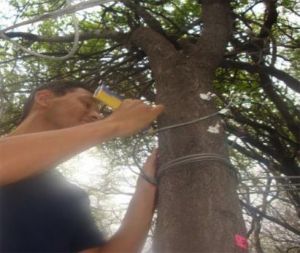Stand level water-use in forests of contrasting rainfall regimes: Assessing the impacts of future drying on native Hawaiian ecosystems

Without baseline information of how Hawai‘i’s dominant native trees take up and transpire water, we cannot quantify the true economic and biological values of maintaining native vegetation that are relevant to managers. Neither can we predict how climate change and invasion will affect the hydrological functioning of Hawai‘i’s watersheds. The objectives of this project are to determine the extent, timing, and longevity of moisture effects on water use, water-use efficiency, and plant growth in a strongly water limited and non-limited forest. We anticipate that the results of this study will facilitate better management decisions by providing two important sets of information: stand-level estimates for dry and wet sites, and detailed information relevant to tree growth and mortality.
We have begun to monitor the seasonality and diurnal trends in sap flux, which represents a component of transpiration of individual trees and species. Stand-level estimates will be scaled up from these sap flux measurements, using several years of plot census data on tree size (basal area and biomass) and growth. Further details of tree growth and mortality will be derived from the sap flux and water-use observations, allowing estimations of tree photosynthesis and gross primary productivity.
The field research is being conducted in an established pair of forest inventory and dynamics research plots located in the Hawai‘i Experimental Tropical Forest (HETF). These plots are part of the HIPPNET plot network (www.hippnet.hawaii.edu), established by Hawai‘i EPSCoR. The Environmental Dynamics and Ecosystem Response (ENDER) Climate team established a coupled climate/vegetation observatory that contains sites across gradients in leeward and windward Hawai‘i Island. Our project focuses on two sites at which we have detailed vegetation data and above-canopy height towers (30-32 m): Laupāhoehoe Natural Area Reserve and the Forest Bird Sanctuary at Pu‘u Wa‘awa‘a. Sap flux sensors were set up on both koa (Acacia koa) and ‘ōhi‘a (Metrosideros polymorpha) trees.

We began investigating seasonality in the diurnal patterns of sap flux with regard to rainfall, on the assumption that species and sites differed in the diurnal patterns of sap flux in response to changing rainfall amount. Preliminary results show that sap flux is driven mainly by photosynthetically active radiation rather than vapor pressure deficit, either diurnally or seasonally. Pu‘u Wa‘awa‘a showed stronger variation in diurnal sap flux, gradually decreasing month by month. This was not seen at Laupāhoehoe, where sap flux and rainfall were both higher throughout the monitoring period. More work will be done on disentangling species differences and the environmental factors partially controlling the sap flux patterns.
The ultimate goal of this study is to provide important baseline information about the hydrological functioning of two native forest types. Understanding the variability in water use within a species and across environments is critical for justifying the value of native forests and their role within the ecosystem.
PROJECT DETAILS
FUNDED:
FY2013
PI:
Rebecca Ostertag
Professor of Biology, UH Hilo
Co-Is:
Thomas Giambelluca
Professor of Geography, UH Mānoa
Christian Giardina
Inst. of Pacific Islands Forestry, US Forest Service
Susan Cordell
Inst. of Pacific Islands Forestry, US Forest Service
Creighton Litton
Dept. Natural Resources & Environmental Mgmt, UH Mānoa
Yoshiyuki Miyazawa
Kyushu University

